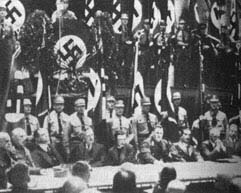German officers attempted to assassinate Nazi leader 60 years ago
The coup was not a success, but Germans still honor brave Nazi resisters

German President Horst Koehler said the date of July 20th, 1944 is an honorable date in the German history. That day was marked with an attempt to assassinate Adolf Hitler. The president said the actions of the plot accomplices against the head of the Third Reich were decisive and courageous. He called the plotters true patriots. “Crimes against humanity cannot be justified,” the German president said. 
A group of German generals and top officers, including colonel-generals Friedrich Olbricht and Ludwig Beck, Major-General Henning von Tresckow, arranged a plot in 1943, having envisaged the defeat in the war. The plotters aimed their efforts against the Nazi Fuehrer. The operation to remove Hitler and seize the headquarters in Berlin was called Walkyria. Members of the Nazi resistance hoped, without Hitler they would conclude peace and avoid the total defeat of Germany.
On July 20th 1944 Lieutenant-Colonel Claus Graf Schenk von Stauffenberg brought a bomb in a briefcase into Hitler's conference room. Stauffenberg was severely injured in North Africa. He lost his eye, the right hand and two fingers on the left hand. He put the case under the Hitler's table and sneaked out of the room. When he heard the blast he decided Hitler was killed. However, Berlin plotters were waiting for the confirmation of Hitler's death too long. General Fromm, the general headquarters commandant decided to save his own life when he found out Hitler survived the explosion. Fromm arrested several plotters, including Stauffenberg, generals Beck and Olbricht. Beck committed suicide, others were executed the same day.
When Stauffenberg placed the briefcase bomb under Hitler's table, an aide moved it aside without any suspicion. The massive oak table protected Hitler, although the blast killed three officers and the stenographer. Hitler was slightly injured.
Gestapo started tracing the plotters immediately. About 200 people were brutally executed after dreadful tortures. Tortures were filmed and then presented to Hitler to watch. General headquarters commandant Friedrich Fromm was arrested too. His cowardly treason did not help him save his life. Hitler's ‘hanging judge’ Ronald Freisler sentenced Fromm to execution.
Cases on state treason were pending in Germany in Volksgerichtshof. More than 5,000 death sentences were brought down there from 1934 to 1945. Ronald Freisler signed almost all of them. Hitler was benevolently watching his career. The Nazi leader entrusted the case on attempted coup to Freisler.
The number of arrested plotters and people implicated in the conspiracy was very large. Court hearings continued for months until Germany's capitulation. Freisler presided over the big process for seven months. He would sit at table against the background of the scarlet banner with swastika in the middle. The judge would yell at exhausted and tortured people, the death sentences of whom he signed personally. He would feel Hitler's look with the back of his head: the bronze head of the Nazi leader was standing behind him on a tall pedestal.
Hitler developed the execution procedure himself. He wanted the plotters to be hanged like slaughtered cattle. They were hanged on steel hooks in a prison cell. The execution was photographed and filmed for Hitler, who watched the tape in the evening.
Based on the materials of Russian media outlets.
Subscribe to Pravda.Ru Telegram channel, Facebook, RSS!


